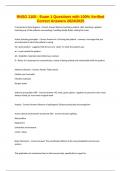RNSG 1105 - Exam 1 Questions with 100% Verified
Correct Answers 2024/2025
5 moments to hand hygeine - Correct Answer Before touching a patient, after touching a patient,
touching any of the patients surroundings, handling bodily fluids, exiting the room.
Active Listening principles - Correct Answer •S -sit facing the patient - conveys e message that you
are interested in what the patient is saying.
•O- open posture - suggests that the you are "open" to what the patient says.
•L—Lean toward the patient.
•E—Establish /maintain intermittent eye contact.
R—Relax. It is important to communicate a sense of being relaxed and comfortable with the patient.
Airborne diseases - Correct Answer Tuberculosis
Chicken pox (varicella)
Measles (rubeola)
Herpes zoster
airborne precautions PPE - Correct Answer n95 mask, gown, gloves, negative air pressure room, door
always closed, pt. must wear surgical mask
Asepsis - Correct Answer Absence of pathogenic (disease producing) microorganism
Assess clinical environment to prevent falls - Correct Answer Lighting
Bed position
Equipment
Unfamiliar environment
Cords / tubes
Body Mechanics - Correct Answer The coordinated efforts of the musculoskeletal and nervous
system.
The application of mechanical laws to the human body, specifically in regard to:
, Structure
Function
Position of the body
It includes:
Proper body movement in daily activities
Prevention and correction of problems associated with posture
Enhancement of coordination and endurance
Chain of infection (and how to prevent HAI each step) - Correct Answer Portal of entry, transmission,
portal of exit, infectious agent, reservoir, host susceptibility
1. Infectious agent (Bacteria, viruses, fungi, rickettsiae, and Protozoai) - Rapid, accurate identification
of organisms
2. Reservoirs (people, equipment, water) - employee health, environmental sanitation,
disinfection/sterilization.
3. Portal of exit (excretions, secretions, skin, droplets) - proper attire, handwashing, control of
excretions and secretions, trash and waste disposal.
4. Means of transmission (direct contact, fomites, ingestion, airborne) - isolation, food handling, air
flow control, sterilization, handwashing
5. Portal of entry (GI tract, respiratory tract, broken skin, mucous membrane) - Aseptic technique,
catheter care, wound care6. Susceptible host (immunosuppression, diabetes, surgery, burns,
cardiopulmonary) - treatment of underlying disease, recognition of high risk patients.
Contact Precaution Diseases - Correct Answer C-diff and MRSA
contact precautions PPE - Correct Answer Gloves, gown
Droplet diseases - Correct Answer Rubella
Mumps




